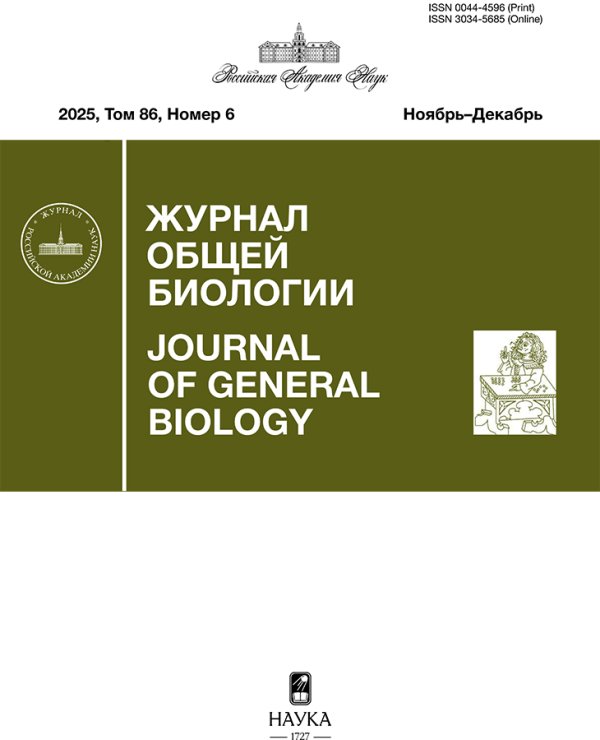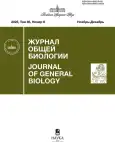Journal of General Biology
ISSN (print): 0044-4596
Media registration certificate: No. FS 77 - 66714 dated 07/28/2016
Founder: Russian Academy of Sciences
Editor-in-Chief: Evgeniy Arkadyevich Kriksunov
Number of issues per year: 6
Indexation: RISC, list of Higher Attestation Commissions, Web of science, CrossRef, White List (level 2)
Biology Bulletin Reviews is a peer-reviewed journal that serves as a valuable source of current and comprehensive information on the state and advancements in biology. It covers a wide range of biological disciplines, including biogeography, botany, zoology, paleontology, embryology, taxonomy, evolutionary theory, physiology, and ecology. The journal also encompasses various aspects of adaptive mechanisms and strategies, genetics and molecular biology, ethology, and biomedical issues. The focus of the journal is to address general biological topics related to the organization and development of diverse life forms on Earth. Although the journal maintains a broad scope, it particularly encourages publications that explore biological macro objects such as organisms, populations, and communities. These studies are crucial for establishing fundamental biological theories and concepts.
Edição corrente
Volume 86, Nº 6 (2025)
(Indexed in “Current Contents”)
The role of RNA-protein granules in neurodevelopment
Resumo
RNA-protein granules are dynamic, membrane-less organelles found in the nucleus and cytoplasm of cells across nearly all organisms, from the unicellular to the multicellular. They are complex assemblies composed of coding and non-coding RNAs, RNA-binding proteins, enzymes, and other proteins. Functionally, they are hubs for RNA storage, transport, signaling, and regulation of translation. A growing body of evidence now underscores their critical role in orchestrating processes within brain development. These granules facilitate neurodevelopment through the spatiotemporal regulation of gene expression; ensuring proteins are synthesized in the right place and time. For instance, the initial division and differentiation of neural precursor cells rely on mechanisms like transcriptional priming, a process facilitated by specific granules – processing bodies. As brain cells mature, RNA-protein granules enable the transport of transcripts to distant cellular sites. There, they regulate local protein synthesis, which is fundamental for cellular morphology, the maturation of dendritic spines, synaptic plasticity, and overall neural circuit connectivity. Furthermore, stress granules, which form transiently in response to cellular stress, are increasingly recognized as players in the developing central nervous system. It is hypothesized that stress granules promote cell survival during stressful events often accompanying embryonic development. Importantly, mutations in genes encoding RNA-protein granule proteins are associated with an increased risk for neurodevelopmental disorders. These mutations disrupt the dynamic nature of RNA-protein granules, leading to disturbances in mRNA localization and expression. Neurodevelopmental disorders linked to these mutations are often characterized by intellectual disability, speech delay, epileptic seizures, and autism spectrum disorder. The review summarizes the current data on the role of these RNA-protein granules – with a focus on stress granules, processing bodies, and transport granules – in shaping brain development.
 405-417
405-417


Latitudinal gradient of taxonomic diversity of plants and animals
Resumo
The paper analyzes research on the global latitudinal gradient of biodiversity, one of the fundamental patterns in ecology and biogeography. The evolution of ideas is traced from the early observations of nineteenth-century naturalists (Humboldt, Wallace) to contemporary quantitative and model approaches. It categorizes and critically analyzes the key hypotheses explaining the increase in species richness in the tropics, including time, climate stability, productivity, spatial heterogeneity, biotic interactions, and area-related hypotheses. It pays special attention to the dynamic nature of the latitudinal gradient of biodiversity through geological time, based on the analysis of paleontological evidence of “flat”, bimodal, and inverse gradients during periods of global warming and mass extinction events. The concepts of the tropics as a “cradle” (center of speciation) and “museum” (low-extinction zone) are integrated, along with the related ideas of “phytospreading” and the “equatorial pump”. The review suggests that the latitudinal gradient of biodiversity is a dynamic pattern formed by the complex interplay of ecological, evolutionary, and historical factors, whose relative roles vary by taxon, region, and geological period.
 418–440
418–440


Scientific discussions
Chronicle of the disappearance of the Yellow-breasted Bunting (Emberiza aureola, Emberizidae, Passeriformes): Spatial structure and population dynamics
Resumo
Due to a sharp decline in numbers, the Yellow-breasted Bunting (Emberiza aureola) is listed as a threatened species on the IUCN Red List. Formerly an abundant inhabitant of meadows, it disappeared as a breeding species in Central Siberia in a short period between 1999 and 2006. We studied breeding density, habitat use, spatial structure and population dynamics of the Yellow-breasted Bunting population in the Yenisei middle taiga since 1978 in the years preceding the decline, and further on. The species showed a narrow specialization in the choice of habitats and occupied rare isolated patches of open habitats in taiga. Most breeding habitats were regularly populated at high densities, reached saturation and indicated a prosperous state of the population. Annual deviations in population size were small and were determined by wintering conditions. Regulation of numbers occurred at breeding sites through strict territorial relationships depending on density. In accordance with the model of ideal despotic distribution, excess individuals in years of increased abundance were displaced to habitats that were unsuitable for reproduction. This distribution was achieved independently in each isolated group of suitable habitats, and the exchange of individuals between groups was minimal. The noted population characteristics, together with the distinctive features of the subspecies E. a. aureola, suggest a long-term dependence of the ecology and dynamics of Yellow-breasted Bunting on the history of rice cultivation in Southeast Asia. The use of anthropogenic food resources in winter was likely reason for both previous expansion and modern decline in numbers due to changes in agricultural technologies. The millennial use of additional winter resources changed the parameters of the species’ life history in the direction of “slow life,” which did not contribute to the formation of adaptations to the conditions of the expanded range in the taiga zone. The current decrease in the availability of winter food has devalued the acquired changes and led to the collapse of the population. The extermination of birds in wintering grounds significantly accelerated the decline in numbers, but was hardly its main cause.
 441-458
441-458


Chronicle of the disappearance of the Yellow-breasted Bunting (Emberiza aureola, Emberizidae, Passeriformes): Seasonal population dynamics and survival
Resumo
The Yellow-breasted Bunting (Emberiza aureola) is a tropical migrant breeding in taiga zone. Once numerous, the species is on the Red List, and since 2017 has been classified as especially threatened. Biological traits of the species are still not studied enough. The purpose of the present study is to fill in the gap with original data on annual survival and seasonal peculiarities of main events on the breeding grounds and determine whether they can play a role in its unlucky fortune. Treating the trapping and marking data on the taiga population in Central Siberia, we carried out the capture-recapture analysis by means of multinomial stochastic modeling. As shown by seasonal dynamics, the phases of the annual cycle allocated to the breeding area are heavily shortened. Some features point out that the dispersal is poorly developed. Annual adult survival reached high values. At the same time, the driver of population fluctuations was the survival rate of one-year-old individuals. The survival has shrunk sharply between 1998 and 2004, so that the population has not recovered thereafter. Based on the data obtained, the connection between the extinction of the population and the recent unprecedented expansion of the species as a probable consequence of the exploitation of rice crops in Southeast Asia is discussed. An excess of food resources in the winter range determined the expansion of the breeding area and significant changes in the annual and life cycle. The sharp depletion of winter resources has led to a modern reduction in numbers and range. To maintain the population of the species, at least local elimination of the causes is necessary. Adaptations acquired during expansion will impede the recovery.
 459-478
459-478












